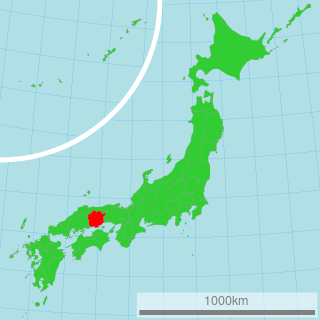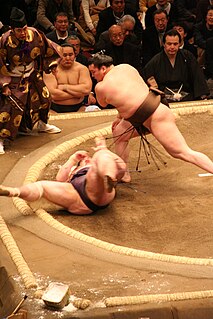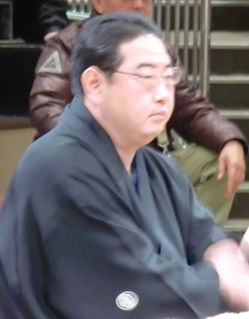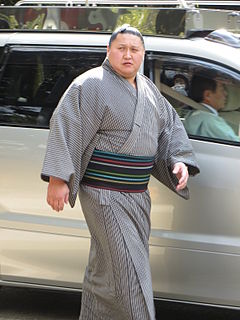
Kyokutenhō Masaru in Nalaikh, Ulan Bator, Mongolia is a former professional sumo wrestler. He made his debut in March 1992 out of Ōshima stable, with the first group of Mongolians ever to join the sport in Japan, reaching the top makuuchi division in January 1998. In his exceptionally long career he received seven special prizes for Fighting Spirit, and won one yūshō, in May 2012 from the maegashira ranks, which made him at 37 the oldest first–time yūshō winner in sumo history, and he was runner-up in one other tournament. His highest rank was sekiwake, which he held on three occasions. He was the first wrestler since the 1950s to be ranked in the top division after the age of 40. He made more appearances in the top division than any other wrestler at 1470, and only Ōshio fought more than his 1870 career bouts. He announced his retirement in July 2015 and declared his intention to stay in sumo as an elder, having acquired Japanese citizenship in 2005. In 2017 he became the head coach of Tomozuna stable and he is known as Tomozuna-oyakata.

Hokutōriki Hideki is a former sumo wrestler, from Tochigi, Japan. He reached the top makuuchi division in 2002 and was runner-up in three tournaments. He had four special prizes in his career and a gold star for defeating yokozuna. The highest rank he reached was sekiwake. He retired in May 2011 and is an elder of the Japan Sumo Association and a coach at Hakkaku stable.

Miyabiyama Tetsushi is a former sumo wrestler from Mito, Ibaraki, Japan. A former amateur champion, he turned professional in 1998. With the exception of two tournaments, he was ranked in the top division of professional sumo from 1999 until the end of his career in 2013, holding the second highest rank of ōzeki from 2000 to 2001. He won eight special prizes and was runner-up in four top division tournaments. He wrestled for Fujishima stable, where he worked as a coach until opening his own Futagoyama stable.
Wakanami Jun was a sumo wrestler from Iwai, Ibaraki, Japan. His highest rank was komusubi. He won a top division tournament championship in March 1968. He was also a sumo coach.
Hasegawa Katsutoshi is a former sumo wrestler from Kurisawa, Hokkaido, Japan. He began his professional career in 1960, reaching the top division in 1965. He won eight special prizes for his achievements in tournaments and earned nine gold stars for defeating yokozuna. He won a tournament championship or yūshō in 1972 and was a runner-up in two other tournaments. His highest rank was sekiwake. He retired in 1976 and became an elder of the Japan Sumo Association, working as a coach at Sadogatake stable until his retirement in 2009.
Maenoyama Tarō is a former sumo wrestler from Osaka Prefecture, Japan. He began his career in 1961, reaching the top makuuchi division in 1966. His highest rank was ōzeki which he held from 1970 until 1972. He retired in 1974 and became head coach of the Takadagawa stable. He left the Sumo Association in 2010 upon turning 65.
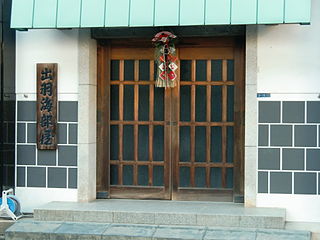
Dewanoumi stable is a stable of sumo wrestlers, part of the Dewanoumi ichimon or group of stables. It has a long, prestigious history. Its current head coach is former maegashira Oginohana. As of January 2018 it had 14 wrestlers.
Ryōgoku Kajinosuke IV is a former sumo wrestler from Nagasaki, Japan. His highest rank was komusubi. He is now a sumo coach.

Hitachiiwa Eitarō was a Japanese sumo wrestler from Tokyo. His highest rank was ōzeki.
Kirinji Kazuharu is a former sumo wrestler from Kashiwa, Chiba Prefecture, Japan. He made his professional debut in 1967, reaching the top makuuchi division in 1974. His highest rank was sekiwake. During his long career he won several awards and set a number of longevity records. Upon his retirement in 1988 he became a sumo coach and elder of the Japan Sumo Association, until reaching 65 years of age in 2018.
Oginishiki Yasutoshi is a former sumo wrestler from Ichikawa, Chiba Prefecture, Japan. His highest rank was komusubi. His father and brother were also sumo wrestlers. He is now a coach at Dewanoumi stable.
Fujinokawa Takeo is a former sumo wrestler from Otofuke, Hokkaido, Japan. He made his professional debut in May 1961 and reached a highest rank of sekiwake in May 1967. He was a runner-up in two top division (makuuchi) tournaments, finishing three wins behind Tamanoshima in May 1968 and losing a playoff to ozeki Kiyokuni in July 1969. He earned four kinboshi for defeating yokozuna and won seven special prizes. After his retirement in 1972 at the age of 26 he became an elder of the Japan Sumo Association and took over as head coach of Isenoumi stable in 1982. He left the Sumo Association in 2011 upon reaching 65 years of age.

Kushimaumi Keita, born as Keita Kushima, was a sumo wrestler from Shingū, Wakayama Prefecture, Japan. A successful amateur, his highest rank in professional sumo was maegashira 1. After his retirement he became an elder of the Japan Sumo Association and established Tagonoura stable.
The following are the events in professional sumo during 2009.
The following are the events in professional sumo during 2003.
Dewanohana Yoshitaka is a former sumo wrestler from Nakasato, Aomori, Japan. He made his professional debut in July 1974, and reached the top division in November 1977. His highest rank was sekiwake. He retired in January 1988 and became an elder in the Japan Sumo Association under the name Dekiyama. Upon reaching the mandatory retirement age of 65 in May 2016 he was re-hired by the Sumo Association for five years as a consultant.

Dewanishiki Tadao was a sumo wrestler from Tokyo, Japan. His highest rank was sekiwake. He won ten kinboshi or gold stars for defeating yokozuna during his long top division career, which only four wrestlers have bettered. He also won four special prizes. After his retirement he was a coach at Dewanoumi stable.

Ōhikari Sadayuki was a sumo wrestler and coach from Kamiiso, Hokkaido, Japan. He made his professional debut in January 1944, reaching the top makuuchi division in 1950. His highest rank was komusubi. He was a runner-up in the May 1956 tournament and earned five kinboshi or gold stars for defeating yokozuna during his career. He retired in 1963 and became an elder of the Japan Sumo Association under the name Ōnomatsu Oyakata, working as a coach at Dewanoumi stable. He died in 1996 at the age of 68.

